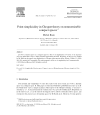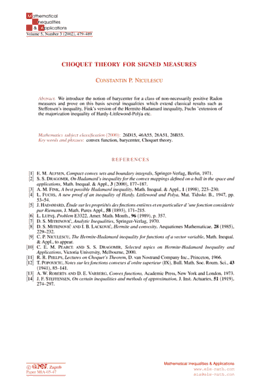Choquet theory
The Choquet theory ( after Gustave Choquet ) is a mathematical theory from the branch of functional analysis. It clarifies the notion that the points of a compact convex set of a locally convex space can be represented as " averaging " over the set of extreme points of this set.
The finite-dimensional case
Is a compact, convex set of a - dimensional real vector space, it can be any point on the Minkowski theorem as a convex combination of extreme points represent approximately. Identifies the Einpunktmaß in, it follows that for any affine
,
Where stands for the set of extreme points. In this sense, therefore, can be represented as averaging with respect to a concentrated on the set of extremal probability measure at any point. The Choquet theory deals with infinite-dimensional generalizations of this fact.
General situation
It is a compact, convex set of a locally convex space. Then, the closure of the set of extreme points of, also compact.
It is the space of all continuous, affine transformations on with values in the real numbers. The restriction map in the algebra of continuous functions is isometric, as easily follows from the Krein - Milman, as is a completed page, which must in turn contain extreme points of. can be understood in this sense as a subspace of.
Now let a point that we " submit " want about the amount of extreme points. The figure is a positive, continuous, linear functional on with norm 1 and can be continued norm equal to a continuous linear functional after by the theorem of Hahn- Banach. According to the Riesz representation theorem, there is therefore a regular Borel measure, such that the following formula is valid:
This is also listed briefly as
,
But what it should mean nothing more than the previous formula. It is said in this case, the point is represented by the dimension. In this sense, the Krein - Milman for a point thus provides a kind of averaging, the point is calculated as the integral with respect to a measure on the closure of the set of extreme points.
In many cases, the infinite-dimensional closure of the set of all extreme points is equal to the compact, convex set itself, so that the above statement is uninteresting, because then you can take the Einpunktmaß in a measure. It would be better if you could do without, as in the finite dimensional case to the final formation, but the amount of extreme points is generally not a Borel set, so that one can not speak of Borel measures on this set. Is the compact convex set but even metrizable, this case does not occur, and the set of Choquet provides a representation of the desired type in the non- metrizable case, you have to formulate because of the lack of measurability and comes to a different set from the Bishop -de Leeuw.
Set of Choquet
Is the compact, convex set is metrizable, then the above-mentioned Messbarkeitsprobleme are not available, because then is the set of extreme points of a quantity and hence Borel measurable.
- Set of Choquet (1956 ): Let be a metrizable, compact, convex set of a locally convex space and. Then there is a probability measure with support in illustrating the point.
Set of Bishop -de Leeuw
When the compact, convex set is not metrizable, it may happen that the set of extreme points is not measurable, and the statement that a measure has support in the set of extreme points, has no meaning. One could weaken this condition by requiring that the measure on each Borel set, with the set of extreme points has an empty intersection, disappears. But even this proves to be insufficient, you must also reduce the observed Borel sets.
Under the Baire -ring ( to RL Baire ) is the percentage of all compact sets generated ring. The elements of this ring are called Baire sets.
- Set of Bishop -de Leeuw (1959 ): Let a compact, convex set of a locally convex space and. Then there is a probability measure which vanishes on each to the set of extreme points disjoint Baire quantity and represents the point.
Comments
The set of Bishop -de Leeuw, who is also sometimes called set of Choquet - Bishop -de Leeuw, is a true generalization of the Choquet, because in a compact, metrizable space, every closed set is a compact set.
The set of Bishop -de Leeuw exacerbated the Krein - Milman, because the latter can be easily recovered from the former. Is point of a compact convex set, as a representative measure of the set of Bishop -de Leeuw apparently has the support in the closure of the set of extreme points. By approximating the measure by discrete dimensions, one sees that in the financial statements of the convex hull of lies, from which can now easily derive the Krein - Milman.
The presented sets have applications in the theory of Banach algebras, which then leads to the concept of Choquet - edge, and also in other areas of functional analysis. For further details, please refer the below textbook by RR Referred Phelps.










